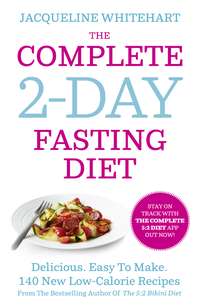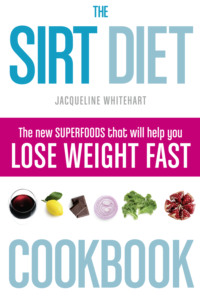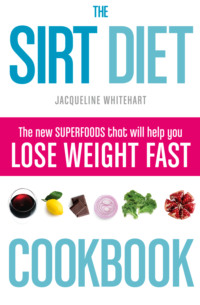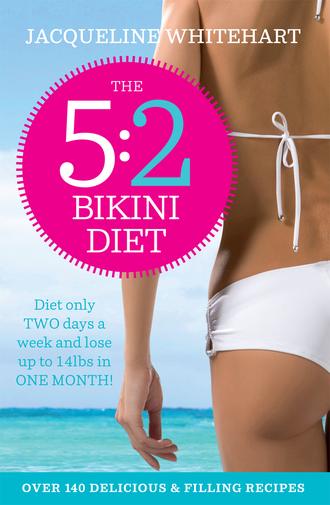
Полная версия
The 5:2 Bikini Diet: Over 140 Delicious Recipes That Will Help You Lose Weight, Fast! Includes Weekly Exercise Plan and Calorie Counter
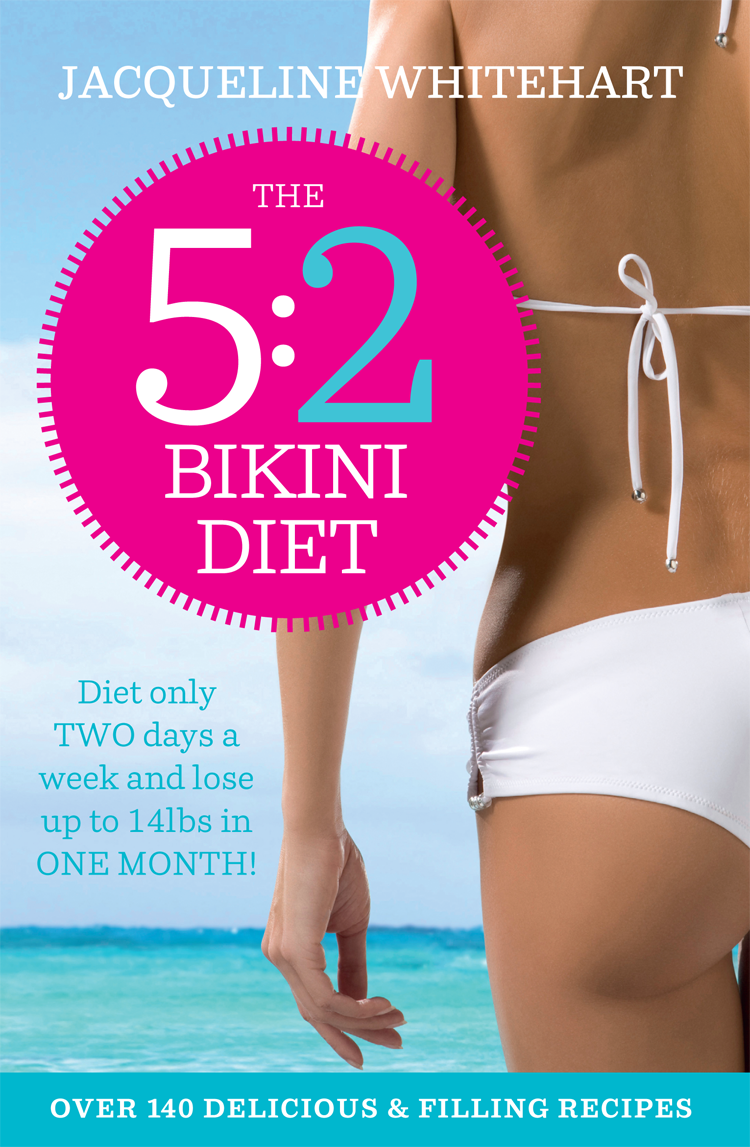

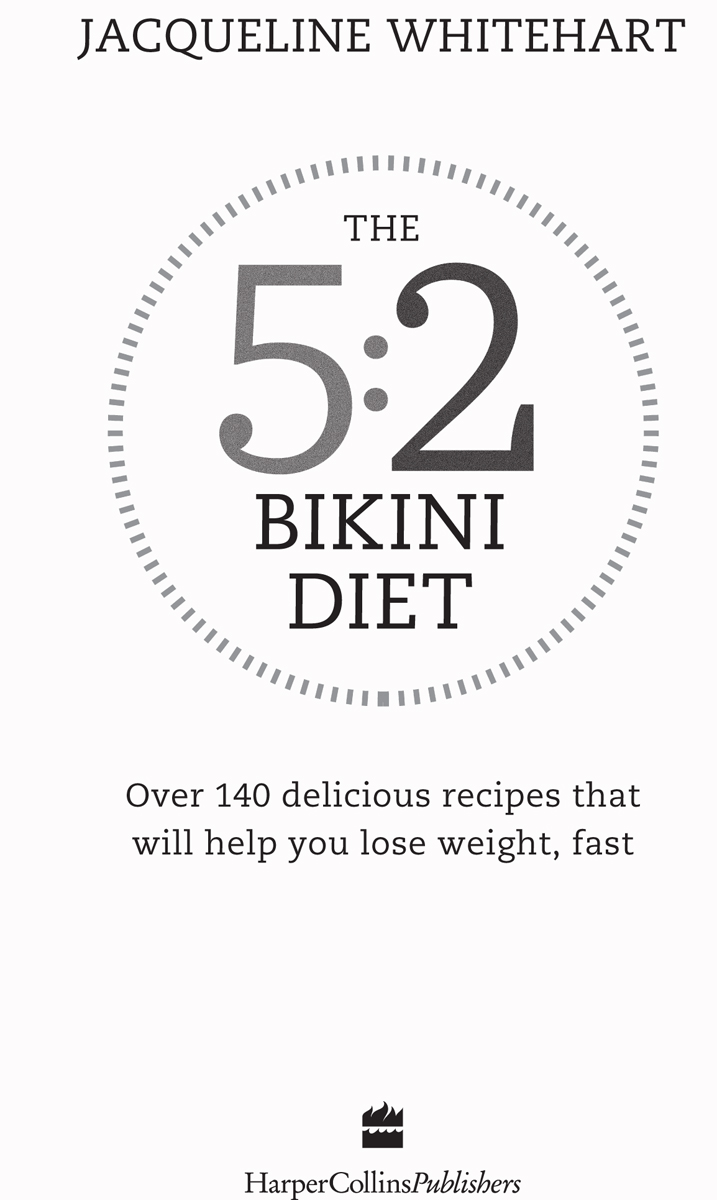

PART 1: THE 5:2 BIKINI DIET
Introduction
The golden rules for a successful diet
Health benefits
The magic numbers
Getting started
Fast days
Normal days
Getting beach fit
Questions and answers
Not just a diet, a way of life
PART 2: THE 4-WEEK PLAN
Week 1
Week 2
Week 3
Week 4
The results
Beyond the 4-week plan
PART 3: THE RECIPES
PART 4: EXERCISE
Calorie counting reference
Plates Section
Credits
Copyright
About the Publisher
For my husband Andy who has helped and supported me both in life-style changes and in my writing. He has also enthusiastically tested out all my new recipes.
For my children Amy, Irie and Max who remind me that life isn’t just a diet.
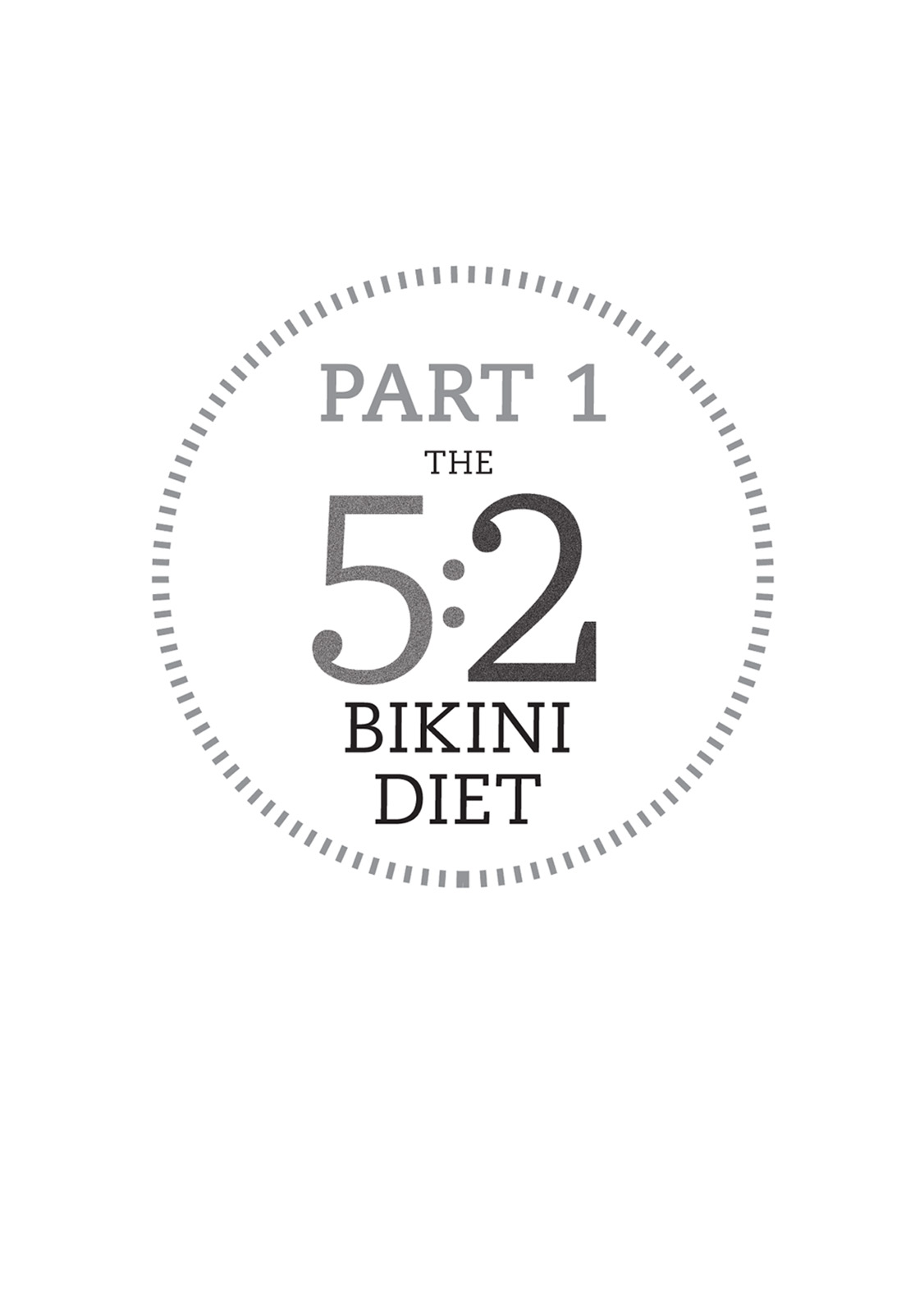

The 5:2 Bikini Diet has something to offer everyone as it’s totally different to other diets – diet twice a week, then eat healthily the rest of the time and watch the weight fall off. As an avid follower of the 5:2 diet since September 2012, I want to share my experiences of this life- and figure-changing diet with the world.
I have created an all-new and delicious selection of healthy and filling recipes that are just perfect for summer. You will find salads, barbecues and super summer desserts, which are all suitable for your fast days.
With the addition of a simple and fun exercise routine, developed by David Jones of Sculpt Health & Fitness, this is the perfect diet to lose weight and get in shape for the summer.
This book is for you if you are new to the diet and want to get started; if you are already a follower of the 5:2 diet and are looking for some extra help or a new start; if you want some fantastic new recipes for summer; if you want an exercise routine that will improve your bikini body or you just want to lose some weight in a healthy and simple way.
Join the 5:2 revolution and be happy with your weight and your body. I’ll see you on the beach!
Yours,

Jacqueline Whitehart, April 2013
THE GOLDEN RULES FOR A SUCCESSFUL DIET
Let’s cut to the chase: there are three steps that we will be following for the next four weeks and beyond to get into shape for the summer. Follow these rules and you will lose weight, feel healthier and look great.
• Fast – eat only 500 calories for women/600 calories for men – on two non-consecutive days per week.
• Eat normally but healthily on the other five days.
• Follow the 30-minute workout plan three times a week on your non-fasting days.
Looks simple doesn’t it? That’s because it is! It’s really simple and easy to follow, so read on and I will guide you through each of the three rules.
1 Fast twice a week
Two days a week you follow a calorie-restricted diet, that’s:
• 500 calories for women
• 600 calories for men
The days are non-consecutive.
2 Eat normally but healthily on the other five days
If you have followed the 5:2 diet before you will be familiar with the term ‘feast’ day, but that’s something that trips people up time and time again. This is because most of us, if told we can eat what we like, go a bit mad.
The five non-fast days are normal and healthy days, they are not diet days and we do not count calories.
DO:
• Enjoy your food and don’t count the calories.
• Eat three healthy meals a day.
• Do NOT snack between meals and avoid processed food.
Cut out the rubbish. Keep the following items to a very bare minimum:
• biscuits (cookies) and cakes
• crisps (potato chips)
• non-diet fizzy drinks
• chocolate bars and sweets (candies)
• beer, lager and cider
If you follow these steps, you will have plenty of scope for tasty plates of food without excluding any food group, and it means that you will be able to have delicious pasta, bread, desserts and, of course, a glass or two of wine.
Remember that the recipes in this book are not just for fast days; they are perfect for your normal days too. Just add some extra carbohydrates, such as rice or potatoes, if necessary and make sure you eat three balanced meals every day.
3 Exercise three times a week
While rules 1 and 2 are for weight loss, exercise makes the most of the weight loss by reducing the flab, toning your body and zapping the cellulite.
If you are new to exercise, then perhaps the best way to get started is walking. Start with walking 15 minutes a day, three days a week and work up from there. Walking is great if you are just starting to exercise as it is proven to significantly improve fitness levels. Walking increases the blood flow to the muscles, improving circulation and heart function. Swimming is also a suitable option if you are just getting started with exercise.
If you are fit and exercise regularly then you should find Sculpt’s 5:2 Bikini Diet exercise plan easy and enjoyable, ready to get your body in shape for the summer – fast!
By following the workout plan three times a week, you can expect great results in just four weeks. There’s more detail about the benefits of combining exercise with the 5:2 diet in the ‘Getting beach fit’ chapter (see here).
HEALTH BENEFITS
Not just slimming
This chapter simply explains the medical reasons for the diet’s success. When you understand how healthy you will become on this diet – as well as slimming easily – you will keep to this lifestyle forever. The slimming results on the 5:2 Bikini Diet are stunning. And not just that, losing weight healthily and easily improves your overall health. There is also increasing evidence that this new breed of fast diet, of which the 5:2 diet is the easiest and most popular, has some incredible benefits for your long-term health too.
What happens in our bodies when we fast?
Based on the opinion of several fasting experts, there is now a picture developing of how the scientists believe intermittent fasting changes the way our bodies work, giving us additional health benefits as we age. Here I provide a simple approach to the science, which I hope will make it clearer to anyone with a general interest, but without a scientific background.
When we deprive our body of food for longer than normal, for example during a fast, we notice changes in some of our hormones. As the levels of certain hormones change, this has a knock-on effect on different types of cells within our body. One of these hormones, Insulin-like Growth Factor 1 (IGF-1), is proven to decrease as we fast. IGF-1 is produced in the liver and is similar to insulin. Its purpose in the body is to make cells grow and produce new cells. When levels of IGF-1 decrease, our body produces fewer new cells and concentrates on repairing old ones. This state of ‘repair’ is very beneficial as it slows down the ageing process and may reduce the risks of cancer, diabetes and heart disease.
Another hormone that fasting seems to affect is a nerve cell growth factor in the brain, which changes the way neurons in the brain grow. This research is in its infancy and has yet to be tested on humans, but there are several indicators that suggest this is the mechanism that ultimately leads to a reduction in risk factors for cognitive diseases such as Alzheimer’s.
There’s a final exciting difference between standard calorie-restricted diets and intermittent fasting. Any weight you lose doing intermittent fasting is body fat! If this is not a reason to do the 5:2 diet over anything else then I don’t know what is.
Other diets may show a decrease in body fat and muscle, but with intermittent fasting it seems to be just fat. Scientists are unsure at present why this is true, but it has been seen in a variety of studies so there is a good scientific basis for these findings. The most likely explanation is that when we fast, we have to use resources in our body (i.e. fat) for fuel rather than the food we have eaten. It may also be the key as to why the 5:2 diet is so successful for so many people.
Optimizing the benefits – do we need to skip meals?
The simple answer is yes. If your primary goal is health benefits, not weight loss, the science suggests you should eat only one meal on a fast day. Remember that how you consume calories over the fast day does not affect weight loss. Top scientists from the United States are in agreement that to get the absolute best out of intermittent fasting you need to either fast completely for 24 hours or, at most, have one small meal in the middle of the 24-hour period. The tests where they try other kinds of calorie restriction over the 24-hour period just haven’t been done yet, so it’s hard to tell for sure whether the science backs this up.
If you’re reading this and thinking, Help, there’s no way I can only eat once a day, then you’re not alone. And this is why I do not advocate skipping meals unless it’s something that appeals to you and it’s something you can see yourself sticking to in the long term.
First and foremost this is because it does not affect the rate at which you slim. If your main objective is to lose weight and gain the health benefits that come with sustained weight loss, then stick to the 500/600 calories on your fast days, but do not worry about when you eat them.
Secondly, although the health benefits may not be optimized, you are still getting some of them. You are fasting and your body is going into repair mode so don’t panic if you are not fully ‘optimized’. Is anything in your life fully optimized? I know it’s not the case for me.
Finally, and most importantly, what do you think is best: having a strict fast with only one meal but finding it so hard and de-motivating that you give up after a month or eating two or three small meals on your fast day and finding it sustainable in the long term?
I’d say the latter is by far the best option, but use your own preference. If you find it easier to skip a meal, then do so. I often, but not always, skip lunch on a fast day. But if three meals a day works for you then don’t change it. You are doing great as you are.
What’s in a name?
There are many different names for diets that are the same or similar to the 5:2 diet, so it’s no wonder people are getting confused.
The fast diet or 5:2 diet
These are, as far as anyone can tell, the same diet – just two names for the same thing. I think the double name comes from the origins of the diet. The 5:2 diet didn’t exist before a TV programme by Michael Mosley in August 2012. Many people, including myself, started following the simple principle of eating less two days per week. At this stage it didn’t have a name and as people were discussing it on Twitter and other social media sites it needed a name, so the simplest name stuck – the 5:2 diet. Later, as the diet became a phenomenon, marketing types got hold of it and it also became known as ‘the fast diet’. In the US, where the diet never grew through word of mouth, it seems to be just called ‘the fast diet’ or ‘the British fast diet’.
The 2-day diet
The 2-day diet has a totally different root to the 5:2 diet, despite its similarity in name and action.
The 2-day diet grew out of some amazing research by Dr Michele Harvie at the University of Manchester over the last few years. Harvie is a breast cancer specialist and has been looking at ways to reduce breast cancer risks through diet. She has done experiments with groups of overweight women, where she radically changed their diets just two days a week. The diet has many similarities to 5:2, in that you restrict calories two days a week and eat normally for five. But the calories are restricted to 650 for both men and women and the food eaten on a fast day is more prescriptive – it includes a certain amount of milk and is totally carbohydrate free (rather like the Atkins diet) on the fast days. Most contrastive to the 5:2 diet is that the two days must be consecutive.
Her research highlighted two important things. First, that dieting two days a week was easier and that more people stuck to it than dieting all the time. Harvie compared two groups of women. The first group fasted two days a week and the second group followed a standard calorie-restricted diet, sticking to 1500 calories a day. After three months of following the diets, the research showed that intermittent fasters were almost twice as likely to stick to their diet.
The second and most impressive finding of her research was the reduction in a breast-cancer-causing hormone called leptin, which was reduced on average by 40 per cent, and a drop in insulin levels of 25 per cent, cutting the diabetes risk in these women.
Alternate day fasting (ADF)
Alternate day fasting originated in the US before the fast diet became popular in the UK. The principles of this diet are very simple. A strict fast diet is followed every other day. It also restricts how many meals you eat in that one day. The 5:2 diet is a variation on this theme, allowing you to fast for fewer days in a week and also to take weekends off. They are similar in terms of weight loss and effects, although obviously you may lose weight faster on ADF. But the success rate (i.e. the number of people who stick to the diet in the long term) is lower.
There has been an interesting study in the US by Dr Varady into ADF. Varady’s research is fascinating. She took a group of both male and female overweight volunteers and started them on ADF for a year. This study is still progressing, but initial results in this case show a low dropout rate, gradual and continued weight loss and falls in both total and LDL (‘bad’) cholesterol.
Window or 8-hour fasting
Window fasting is a slightly different way of structuring your fast days. You fast for a part of your day, seven days a week. For example, a popular structure is that you fast from 8 p.m. on one day until 12 p.m. the following day. This means that your eating ‘window’ is 12 p.m. to 8 p.m. every day. Some people find that this kind of fasting fits more naturally into their lifestyle as they can eat a normal lunch and dinner every day, but it’s definitely not to everyone’s taste.
There has not been much research into this particular type of intermittent fasting, but the results are likely to be similar to that of 5:2 fasting or ADF.
Intermittent fasting (IF)
Intermittent fasting is a coverall term for any type of fasting diet. So the 5:2 diet, the fast diet, the 2-day diet and ADF all come under the umbrella of intermittent fasting.
The advantages of 5:2/fast diet over other forms of intermittent fasting
There is a reason why more people follow the 5:2 diet than any other form of IF – you are more likely to have success because it’s easier to stick to and simpler to fit into your lifestyle. The dropout rate is lower than other types of IF and, indeed, than other types of diet. Put simply, the 5:2 diet is the simplest and most sustainable fast diet.
Possible dangers and side effects of the 5:2 diet
Because this diet is a fairly radical approach to weight loss, it is wise to speak to your doctor first to see if it is safe to follow the diet.
Current medical opinion suggests that the benefits of fasting are unproven. This is because long-term studies take several years, or even decades, to complete and this is a relatively new field.
The good news is that no significant dangers or problems with the diet have been reported so far. We can also take note that certain religions have been fasting for hundreds of years. Fasting during Ramadan requires Muslims to fast during daylight hours for a month. Fasting is also common among most Hindus. They fast on certain days of the week based on their belief and to appease certain deities. Both Hindus and Muslims believe that fasting is important for the wellbeing of human beings as it nourishes both physical and spiritual needs.
What about side effects?
As with all big changes to your normal diet and routine, there can be side effects. Some people will not experience any side effects, but a few will find the side effects to be so uncomfortable that they will be unable to continue with the diet.
Some of the side effects seem to occur only when fasting is first attempted. These effects, such as headaches and dizziness, will diminish and hopefully disappear altogether over a period of several weeks.
Dehydration seems to be a common side effect of following the fasting diet that doesn’t fade in time. It is easily dealt with by sipping plenty of water or other low-calorie drinks regularly throughout the fasting day.
What about irritability? Yes, some of us do get grumpy when we are feeling hungry. This does seem to reduce as we get used to fasting. But I can get grumpy on fast days and normal days too!
Some people report difficulties sleeping due to hunger and daytime sleepiness. This is less common than other symptoms. Most people feel a buzz of energy during their fasting days. Difficulties sleeping can occur, particularly if you eat the majority of your calories during the early part of the day. Increasing the size of the evening meal and making sure it is rich in complex, filling carbohydrates helps the body feel sustained until after we go to sleep.
Finally, here’s one side effect that has affected me. I’ve been feeling the cold all through the winter, but particularly on fasting days. It has been a rather cold winter this year, but I have been suffering more than I would expect. The result has been an increased wearing of jumpers – perhaps two or three at a time and a higher heating bill. I take comfort in the fact that this is likely to mean that my body fat is reduced and the diet is working well.
Fasting and hypoglycaemia
If you suffer from, or might be suffering from, hypoglycaemia as a medical condition consult your doctor before beginning the diet.
The feeling of low blood sugar when you haven’t eaten for a few hours is a common problem and one which I have suffered from in the past. It may put someone off fasting, because they feel that they need to eat every couple of hours to keep their blood sugar stable. The basic problem is that if you don’t eat every three or four hours then you can become hypoglycaemic and therefore irritable, moody, light-headed and shaky.
This is an interesting phenomenon as only a small proportion of the population actually have a malfunction in their ability to regulate blood sugar levels. The rest of us, who do not have an underlying medical condition, do not have to worry about getting ‘low blood sugar’ while fasting. This is because the body is amazingly effective at regulating the sugar flowing around the blood.
A study in which young adults who have symptoms of hypoglycaemia went on a monitored 24-hour fast found that, while they reported ‘feeling hypoglycaemic, their blood sugar levels remained normal. What to do if you are worried about having a ‘blood sugar crash’ during a fast period? This is a very real problem that I myself suffered from when I started the diet. I now know that my blood sugar levels are fine; I am in fact just exceptionally hungry. Here are my tips that helped me get through it, which I hope will help you too.
• Eat regularly during your fast day – this means three small meals.
• If you feel a wave of light-headedness coming over you, know that it will in all likelihood pass and you will feel normal again in 15 minutes.
• Finally, if it affects your ability to function normally or gives you a headache then you should eat something – nothing that big, ideally 100 calories or so of something filling, a slice of toast or a small banana, for example. Allow yourself those extra calories for that day, but carry on with the fast day if possible.
Don’t let it put you off your next fast day, which will probably be easier. On your next fast day, see if you can last longer without feeling poorly.
When not to fast?
There are certain medical conditions that would make fasting inadvisable or even dangerous, even in this more restrained form. Don’t attempt fasting if you are diabetic or pre-diabetic without seeking medical advice first. It is also not suitable if you are pregnant, breastfeeding or under 18 years old. If you are in any doubt, you must see your doctor first to discuss your options for dieting.
Those who are lucky enough to have good health and for whom fasting is a sensible diet option should also consider that there are some days that prove difficult for fasting.
If you’re already a 5:2er, you will already know that some fast days will breeze by while others will be hard. There have been a few times where I have chosen not to fast or given up on a fasting day halfway through. I don’t feel bad about this because I made the choice for the good of my short-term health and restarted the diet as soon as I felt better. Some of the things that have caused me to consider whether I should be fasting that day include a cold (it’s hard to fast when you have a bad cold, so my advice is: don’t fast), when I’ve had little or no sleep and possibly, for women only, at certain times of your monthly cycle.




